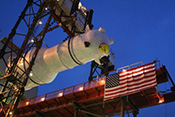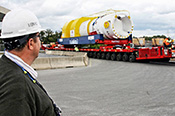Backgrounder on Steam Generator Tube Issues
On this page:
- Background
- NRC Regulations
- Tube Materials
- Tube Degradation
- Tube Repair Criteria
- Inspection Issues
- NRC's Steam Generator Regulatory Framework
- Generic Communications Related to Steam Generator Tube Integrity
Background
There are two primary types of nuclear reactors, which use slightly different approaches to generating electricity. Pressurized water reactors – referred to as PWRs – use steam generators to convert water into steam using the reactor core’s heat. Boiling water reactors don’t use steam generators.

Steam generators are significant pieces of equipment. They can be up to 70 feet tall and weigh as much as 800 tons. Hot radioactive water from the reactor enters the generator and flows through thousands of feet of tubing under high pressure to prevent it from boiling. Steam generators hold from 3,000 to 16,000 tubes, each about three-quarters of an inch in diameter. The water inside the tubes heats non-radioactive water on the outside, which makes steam. This non-radioactive steam turns a turbine to make electricity. The steam is then condensed back into water for another trip through the steam generator.
Steam generator tubes help protect the public. They are one of a PWR’s many barriers between the radioactive nuclear fuel and the environment. A plant can release the non-radioactive steam to the atmosphere in some situations. This means it’s important the tubes remain intact and prevent radioactivity from the reactor core from reaching the atmosphere in the released steam.
NRC Regulations
Before the NRC allows a PWR to operate, the plant owner must show the plant can keep the public safe even if a very unlikely tube rupture happens. The plant must show radiation doses beyond the plant’s fence would stay below the NRC’s conservative limits (described in Title 10 of the Code of Federal Regulations, Part 100). Plant operators must also have emergency procedures for safely dealing with steam generator tube ruptures and leaks.
The NRC requires periodic steam generator tube inspections to detect possible damage before anything happens. Agency rules also require plants to monitor water chemistry to detect radiation from any tube leakage. These requirements work together to ensure an extremely low chance of tube leakage that could affect the environment.
Tubes with flaws beyond a certain limit must be repaired or more often removed from use by plugging. Detailed technical specifications for each PWR describe the inspection frequency and scope, applicable tube repair limits and reporting requirements. Operating leakage limits – if reached – would force a plant to shut down quickly.
Tube Materials
The nickel-chromium-steel alloys and construction methods used to build steam generators affect a tube’s ability to resist wear and corrosion. In the U.S., steam generator tubes are made of Alloy 600 and Alloy 690, with 690 having more chromium to better resist corrosion. Thermally treating these alloys after the tubes are formed further improves their resistance to corrosion. Tubes that have not been thermally treated are referred to as mill-annealed tubes. The majority of PWRs in the U.S. (73 percent) have steam generators with thermally treated Alloy 690 tubes.
Tube Degradation
During the early-to-mid 1970s, all but one PWR had mill-annealed Alloy 600 steam generator tubes. Research showed these generators’ tube walls were thinning due to the chemistry of the water flowing around them. PWRs have changed their water chemistry since then, virtually eliminating that source of tube thinning.
Tube denting became a primary concern in the mid-to-late 1970s. Denting is caused by corrosion of the carbon steel support plates in the steam generators, which builds up material in the crevices between tubes and the tube support plates. Plants control denting through changes in water chemistry on the non-radioactive side of the generator.
These problems forced plants to shut down more often for additional tube inspections. Many plants replaced their mill-annealed Alloy 600 steam generators and a few PWRs permanently shut down because of these problems.

The nuclear power industry worked to reduce steam generator tube corrosion in the early 1970s. In the late 1970s, the thermal treatment process was developed to improve Alloy 600 tubes’ resistance to corrosion. Replacement steam generators with thermally treated tubes were first used in the early 1980s. These replacements have avoided significant degradation problems. Replacement steam generators built after 1989 have primarily used thermally treated Alloy 690, which is even better at resisting corrosion.
Makers of newer steam generators, including all replacement steam generators, have taken other steps to reduce corrosion-related damage. Stainless steel tube support plates help minimize denting and new fabrication techniques minimize mechanical stress that can lead to future damage.
Some tubes, mostly mill-annealed Alloy 600, have cracked from a combination of stress and corrosion. A small percentage of thermally treated Alloy 600 tubes have also cracked this way. Thermally treated Alloy 690 tubes have yet to demonstrate this stress corrosion cracking. The NRC and the industry continue researching causes of corrosion and cracking in steam generator and reactor materials.
Steam generator tubes have also been damaged by mechanical wear. In January 2012, the San Onofre Unit 3 reactor experienced a small reactor coolant leak from one of its steam generators to the atmosphere. The utility licensed to operate the plant, Southern California Edison, reviewed information from the event and while the leak was significantly lower than the NRC’s strict limits, follow-up tube inspections in Unit 3 and Unit 2 found unexpected mechanical wear. San Onofre was permanently shut down in 2013.
Tube Repair Criteria
One way to maintain tube integrity is to require a minimum tube wall thickness to protect against leakage and bursting. The original wall thickness limit for most PWRs was 60 percent of the original tube wall; tubes with walls thinner than that are removed from service or repaired. Some tube portions handle flaws better, and the NRC has reviewed and approved alternate repair requirements for those sections. The first alternate repair was approved in 1995 and described in Generic Letter 95-05. Since then, a few additional alternate repair criteria have been approved for other tube portions.
Inspection Issues
Inspections are critical in maintaining steam generator tube integrity. The details and schedule for these inspections depend on each plant’s operating experience. For example, plants with mill-annealed Alloy 600 tubes typically inspect all tubes during every scheduled shutdown.
In December 1997, the NRC gave PWRs more guidance on properly maintaining their tubes. Generic Letter 97-05 discusses measuring tube flaw size, while Generic Letter 97-06 emphasizes the importance of properly examining the rest of the steam generator’s internal parts. The NRC issued the second letter based on foreign and U.S. operating experience with degradation and damage to tube supports and tube bundle wrappers.
The NRC provided another update in November 2000. Regulatory Issue Summary 00-022 covers 10 issues the NRC encountered in reviewing tube integrity at several facilities. Additional updates are listed at the end of this document.
NRC's Steam Generator Regulatory Framework
In late 1997, the Nuclear Energy Institute coordinated the industry’s effort to improve both the quality and consistency of steam generator programs. This led to all U.S. PWRs adopting NEI 97-06, “Steam Generator Program Guidelines.”
In 2003, a task force of industry specialists published new steam generator requirements that the NRC approved in 2005. In January 2006, the NRC discussed the new requirements and plant implementation of NEI 97-06 in Generic Letter 2006-01. All U.S. PWRs responded to the letter by adopting the task force requirements.
The NRC twice clarified some of the requirements as plants were implementing the task force’s work. Regulatory Issue Summary 2007-20 clarified the NRC position on leakage performance criteria. Regulatory Issue Summary 2009-04 clarified the NRC position on inspection requirements.
The task force learned from the plants’ experience with those requirements. The task force revised both inspection schedules and the ways plants select tubes for inspection in a March 2009 document. The revision’s editorial corrections, changes, and clarifications better aligned with other industry guidance documents. The NRC approved these additional revisions in October 2011.
In 2021, the NRC examined additional operating experience and approved longer inspection intervals for thermally treated Alloy 600 and Alloy 690 steam generator tubing. For thermally treated Alloy 600 steam generator tubing only, the NRC approved a conditional inspection interval if the plant has no cracking history and the plant performs all its tube inspections with enhanced probes.
Generic Communications Related to Steam Generator Tube Integrity
The NRC continues to monitor industry experience with steam generator tubes. The agency issues “generic communications” to share that information with U.S. plants. These documents appear on the NRC website. Some steam generator generic communications include:
Regulatory Issue Summary 2016-03, “10 CFR 50.59 Issues Identified in NRC’s San Onofre Steam Generator Tube Degradation Lessons Learned Report,” dated April 13, 2016.
Regulatory Issue Summary 16-02, “Design Basis Issues Related to Tube-to-Tubesheet Joints in Pressurized-Water Reactor Steam Generators,” dated March 23, 2016
Information Notice 2013-20, “Steam Generator Channel Head and Tubesheet Degradation,” dated Oct. 3, 2013.
Information Notice 2012-07, “Tube-To-Tube Contact Resulting in Wear in Once-Through Steam Generators,” dated July 17, 2012.
Information Notice 2010-21, “Crack-Like Indication in the U-Bend Region of a Thermally Treated Alloy 600 Steam Generator Tube,” dated Oct. 6, 2010.
Information Notice 2010-07, “Welding Defects in Replacement Steam Generators,” dated April 5, 2010.
Information Notice 2010-05, “Management of Steam Generator Loose Parts and Automated Eddy Current Data Analysis,” dated Feb. 3, 2010.
Information Notice 2008-07, “Cracking Indications in Thermally Treated Alloy 600 Steam Generator Tubes,” dated April 24, 2008.
Information Notice 2007-37, “Buildup of Deposits in Steam Generators,” dated Nov. 23, 2007.
Information Notice 2005-29, “Steam Generator Tube and Support Configuration,” dated Oct. 27, 2005.
June 2024
Page Last Reviewed/Updated Thursday, February 20, 2025
Page Last Reviewed/Updated Thursday, February 20, 2025

